Aphids in Barley 2008 - Impact and Management
| Date: 26 Nov 2009
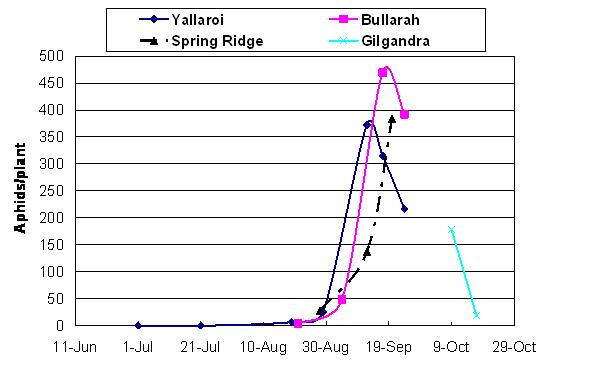
GRDC code
NGA00001: validation and integration of new technology through grower groups in north-west NSW and south-west Queensland grain growing zones
NGA00002: validation and integration of new technology through grower groups in north-east NSW grain growing zones
Background
Aphid infestations in barley (and to a lesser extent in other winter cereals) appear to have been occurring both at higher densities and more frequently in recent seasons. This was the first year of a project hoping to generate regional data in a number of different areas:
1. How much yield impact do aphids have in barley?
2. Can a seed treatment provide a useful benefit and how does it compare with a foliar insecticide application?
3. What thresholds are appropriate under northern conditions?
4. What are the aphid population dynamics?
The approach
Four small plot trials were conducted in 2008 in collaboration with the northern barley agronomy group led by Dr Guy McMullen, NSW DPI. The barley group planted and harvested all trials as well conducted grain quality assessment. NGA were responsible for field monitoring and foliar insecticide application.
Table 1. Site details
|
Location
|
Planting date
|
Harvest date
|
|
Yallaroi
|
June 10
|
November 5
|
|
Bullarah
|
June 12
|
November 12
|
|
Spring Ridge
|
May 28
|
November 17
|
|
Gilgandra
|
June 24
|
November 14
|
Three varieties were evaluated at each site (Fitzroy , Grout and Gairdner ) with four replicates of all treatments. All varieties were planted at equivalent viable seeds per plot with sowing rates of 43-46 kg/ha. Four insecticide treatments were evaluated at each site:
• Untreated - seed treated with Baytan® (triadimenol) only
• Seed treated with Zorro® (triadimenol + imidacloprid) 400 mL/100 kg seed
• Seed treated with Baytan followed by two different foliar insecticide treatments
At Yallaroi and Bullarah dimethoate was applied at two different timings whilst at Spring Ridge and Gilgandra dimethoate and Pirimor® were applied at the same timing. Dimethoate was applied at 500 mL/ha in all situations. Pirimor was applied at 150 g/ha at Spring Ridge and 300 g/ha at Gilgandra.
Crop emergence
There was no significant difference in emergence between Baytan and Zorro treated seed in any trial or on any variety.
Population dynamics
Multiple aphid species were found in every trial:
• Oat aphid (Rhopalosiphum padi) - first species detected at most sites, generally in ‘crown’ region at or near ground level. Individuals later often scattered in lower to mid canopy
• Corn aphid (Rhopalosiphum maidis) - found on upper leaf whorls in very dense colonies with rapid build-up and decline in numbers
• Rose-grain aphid (Metopolophium dirhodum) - numbers built up later in all trials and often found in colonies on the underside of leaves
Figure 1. Aphid populations in Untreated
In 2008 there was a general pattern that aphid numbers built up rapidly from the end of August/ early September with a rapid natural decline at most sites by the end of September/ early October.
Treatment affect on aphid numbers
Figure 2 shows the treatment impact on aphid numbers at Yallaroi (the most intensively sampled site) 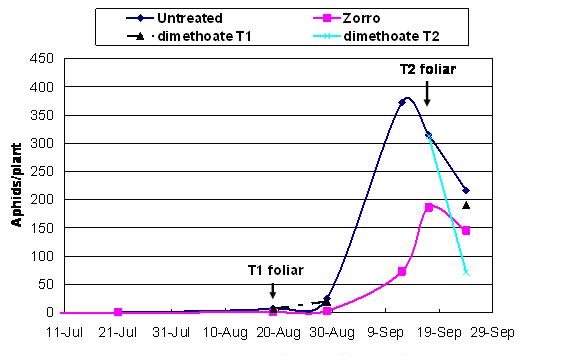
Figure 2. Aphid management at Yallaroi
Zorro resulted in significant levels of aphid control in all trials and at all assessments prior to early September. However figure 2 clearly shows the ‘delayed’ build-up of aphids in the Zorro treatment during September. This pattern was common in all trials assessed to the end of September. The Timing 1 (T1) foliar application at this site was an attempt to manage oat aphids that had colonised the ‘crown’ region.
• Zorro provided extended suppression of aphid numbers but did NOT give season long control
• Dimethoate applied to ‘crown’ colonising aphids did NOT provide significant levels of control (although there was a weak trend to reduced aphid counts at both sites)
• Both Pirimor and dimethoate provided similar (but not complete) control in all trials when applied on ‘foliar’ colonies
• There were no consistent varietal differences in aphid numbers or level of control
Yield
Factorial analysis showed there was no significant interaction in yield for variety x insecticide at any location. All yield results below are for the ‘overall’ insecticide performance. 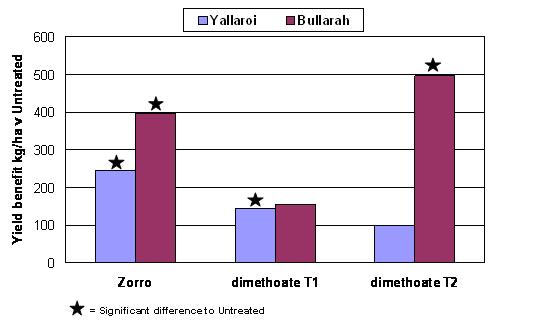
Figure 3. Yallaroi and Bullarah
At both sites an early spray of dimethoate was applied on ‘crown’ colonising oat aphids. Timing 2 (T2) was applied on ~65 aphids/tiller at Yallaroi and ~95 aphids/tiller at Bullarah. In both trials T2 was applied at, or shortly after, the peak in aphid numbers. Untreated yields: Yallaroi 3.5 t/ha and Bullarah 2.5 t/ha.
• All treatments recorded higher yields than the Untreated at both sites
• Zorro resulted in a significant yield benefit compared to the Untreated at both sites
• T2 at Yallaroi provided the best final aphid control but appeared to be too late to provide significant yield protection
• More apparent benefit from T2 application at heavier aphid pressure site 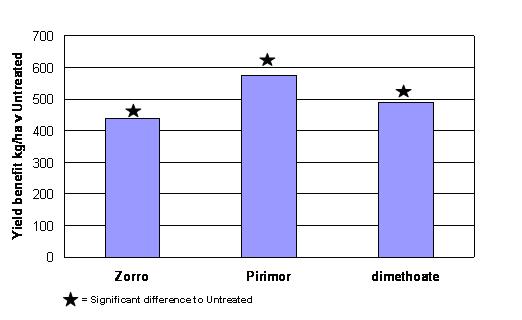
Figure 4. Spring Ridge
Pirimor (150 g/ha) and dimethoate were applied to a population of ~26 aphids/tiller. This site differed to others in that the foliar application was made as the aphid population was starting to build up, NOT already at its peak or declining (the Untreated recorded 74 aphids/tiller 8 days after foliar application). There was no significant difference in aphid control between Zorro and either foliar insecticide. Untreated yield was 4.8 t/ha
• All treatments recorded significantly higher yields than the Untreated, with no difference between treatments 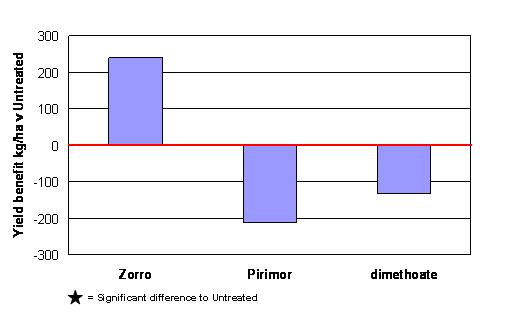
Figure 5. Gilgandra
Pirimor (300 g/ha) and dimethoate were applied to a population of ~36 aphids/tiller in early October, ~3-4 weeks after all other sites, when all varieties had completed head emergence. The intent was to examine whether there were still benefits from a foliar application at this late stage. Although moderate aphid numbers were present at time of spraying, the Untreated population had dropped to 4 aphids/tiller within 8 days of spraying. Under conditions of rapid population decline neither foliar insecticide provided significant control. Untreated yield was 2.8 t/ha
• No treatment recorded significantly different yield than the Untreated.
• The apparent trend to reduced yield from both foliar treatments is likely to be experimental error associated with crop damage from the very late application.
Grain quality
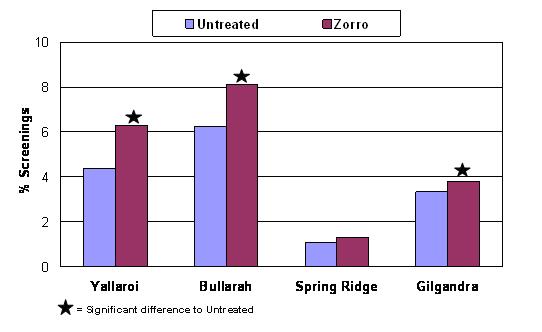
Figure 6. Screenings Zorro v Untreated all sites
• Zorro resulted in a clear trend to increased screenings at all sites
• Foliar insecticide application on ‘foliar’ colonies trended to equivalent or marginally reduced screenings compared to the Untreated 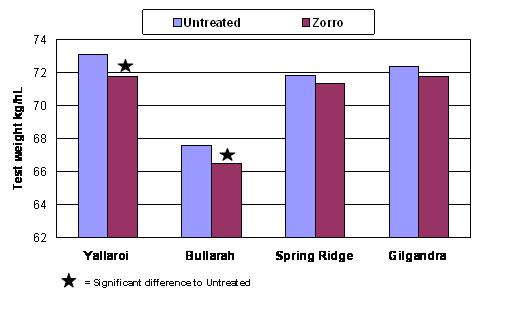
Figure 7. Test weight Zorro v Untreated all sites
• Zorro resulted in a clear trend to reduced test weight at all sites
• There was no apparent impact from foliar insecticide application on test weight
Quality classification
There was no difference in receival grade for any treatment, on any variety, at any site. At Yallaroi, Bullarah and Gilgandra all treatments were eligible for Feed 1 delivery. At Spring Ridge both Fitzroy and Gairdner were eligible for Malt 1, Grout was eligible for Feed 1.
Table 2: Net Cost/ Benefit ($/ha) v Untreated
|
|
Yallaroi
|
Bullarah
|
Spring Ridge
|
Gilgandra
|
|
Zorro
|
+22
|
+41
|
+46
|
+21
|
|
dimethoate (‘crown’ colonies)
|
+5
|
+7
|
na
|
na
|
|
Pirimor
|
na
|
na
|
+57
|
-41
|
|
dimethoate (‘foliar’ colonies)
|
0
|
+50
|
+49
|
-29
|
Conclusions
This is the first year of detailed regional trial work investigating aphid impact with a range of management approaches. Clearly we do NOT know if these results are representative of average conditions. General conclusions on the basis of 2008 results are:
1. Although good levels of benefit were obtained with most treatments, 2008 was a season with high aphid pressure. Results may differ under lower aphid pressure
2. There was no indication of barley yellow dwarf virus (BYDV) at any site. Yield and quality effects appear to be due to aphid feeding activity
3. Zorro provided consistent levels of aphid management until late August/early September and resulted in an average net benefit of $33/ha across all sites (range $21-46/ha)
4. Although not impacting quality classification in 2008, Zorro did result in higher screenings and lower test weight than the Untreated. When combined with the increased yield, this indicates the Zorro treatment allowed increased grain numbers to be maintained compared to other treatments
5. The high aphid numbers, and level of benefit from foliar aphid control, suggests the Zorro impact was primarily from aphid management rather than a ‘stress shield’ effect
6. Dimethoate application on oat aphids in the ‘crown’ area provided poor levels of aphid suppression but still resulted in small yield and net return benefits
7. Pirimor and dimethoate provided similar levels of aphid control and similar net returns
8. The most consistent foliar insecticide results were obtained when sprays were applied early in the ‘foliar’ population build-up eg Spring Ridge
9. Aphid numbers increased exponentially in early September. If consistent, this makes a field threshold difficult to practically manage (eg at Spring Ridge numbers tripled in an 8 day period)
10. The late foliar applications at Gilgandra did not provide any benefit
The 2008 activity has provided some information on benefits and approaches to consider in a high aphid pressure season. However it highlights our limited understanding of the impact of aphids in winter cereals. Future work needs to address a number of areas including:
• Understanding the population dynamics of the different species
• Do all three aphid species have a similar economic impact?
• Can an IPM approach assist in lowering/ delaying pest pressure?
• Zorro direct aphid activity appeared to have ceased by early September. In a high aphid pressure season, is there an additive impact of early protection with seed treatment topped up with foliar insecticide?
Acknowledgements
Thanks to the many growers and consultants involved in this trial work, the support and advice of Melina Miles and the QDPI entomology team, the northern barley agronomy group, Bayer CropScience, Syngenta and Nufarm for provision of product samples and Clare Felton-Taylor for field co-ordination.
Contact details
Richard Daniel & Lawrie Price
Northern Grower Alliance
Ph: 07 4639 5344
Emails: richard.daniel@nga.org.au or lawrie.price@nga.org.au
® Registered trademark
Varieties displaying this symbol beside them are protected under the Plant Breeders Rights Act 1994.
Was this page helpful?
YOUR FEEDBACK
